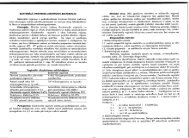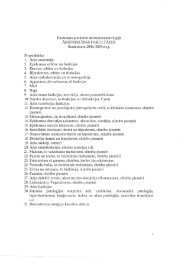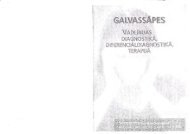PHYSICS
n - susliks.lv
n - susliks.lv
- No tags were found...
You also want an ePaper? Increase the reach of your titles
YUMPU automatically turns print PDFs into web optimized ePapers that Google loves.
~ /). Q ~ /). Q 2 .<br />
L.J __11 + L.J --' = 0 (12.13)<br />
i jrli i jr2i<br />
In general, we can write this condition in the integral form:<br />
J dQ + J dQ = 0<br />
or (12.14)<br />
AaB T AbB T<br />
fdi = 0 (12.15)<br />
Here the symbol f indicates that the integration is over a<br />
closed path.<br />
The change in entropy (dS) between two equilibrium states is<br />
given by the heat transferred, divided by the absolute temperature<br />
of the system in this interval:<br />
dQ = dS<br />
(12.16)<br />
T<br />
The function S is called entropy. The entropy is a measure of<br />
the amount of energy in a physical system which cannot be used<br />
to do work. It is a measure of the disorder present in a system.<br />
At the end of the cycle, be it reversible or irreversible, there<br />
is no change in the system's entropy because it has returned to its<br />
original state. For irreversible cycles, it means that the system<br />
expels more heat to the exterior. This may be summarized as<br />
follows:<br />
For a reversible state: dS = dQ . t.S = t. dQ = 0 (12.17)<br />
T ' r r T<br />
For an irreversible state: dS > di ; fS = 0, f di < 0 (12.18)<br />
The statement can be made more precise by expressing the<br />
entropy change (dS) as a sum of two parts:<br />
dS = d e S + dS ,<br />
(12.19)<br />
where deS is the change of the system's entropy due to exchange<br />
of energy and matter and d.S is the change in entropy due to<br />
irreversible processes within the system. The quantity deS could be<br />
positive or negative, but dS can only be greater than or equal to<br />
zero.<br />
The main tendencies of the entropy exchange are:<br />
a. For isolated systems, since there is no exchange of energy or<br />
matter:<br />
d e S = 0 and dS , ~ 0 (12.20)<br />
b. For closed systems that exchange energy but not matter:<br />
d S = dQ = dU + pdV and dS ~ 0 (12.21)<br />
e T T ,<br />
c. For open systems that exchange both matter and energy:<br />
dU + pdV<br />
deS = jr + (deS)maller and as ~ 0 (12.22)<br />
Whether we consider isolated, closed or open systems, diS?O.<br />
This is the statement of the Second Law in its most general form.<br />
12.8. THE EQUILIBRIUM STATE<br />
Entropy and the second law of thermodynamics provide the<br />
key to understanding equilibrium. An isolated system may undergo<br />
various spontaneous changes, some of which will increase its entropy.<br />
If the total entropy increases during a process, as it usually<br />
does, the process is irreversible - it is impossible to return to the<br />
starting point, leaving no other traces, since that would require a<br />
decrease in the total entropy, which is impossible. Once entropy<br />
has increased, it cannot decrease again. An isolated system therefore<br />
approaches a state in which entropy has the highest possible<br />
value (S ---7 S max ) - this is a state of equilibrium. In this state, the<br />
entropy of the system cannot increase (because it is already at a<br />
maximum) and it cannot decrease (because that would violate the<br />
second law of thermodynamics (dS ~ 0)). The only changes<br />
allowed are those in which entropy remains constant.<br />
Chapter 13. THERMOREGULATION<br />
'i,",:ilI;i("ltiIW;'t'"'''''"'·''".1~'':;~'l)J;''fjff;i''~if,q".!ic':tW'~\It!5i'i~N@!V};l~t0t~i~'%W1iV;~Ii4')",,"~lilCiiliR~~<br />
13.1. PATTERN OF BODY TEMPERATURE<br />
Temperature of a body directly reflects that of the environment<br />
among cold-blooded (poikilothermic) animals, such as insects,<br />
snakes and lizards. These creatures maintain safe body tempera<br />
94 95






